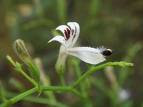classification of Calotropis gigantea
Kingdom: Plantae
Order: Gentianales
Family: Apocynaceae
Subfamily: Asclepiadoideae
Genus: Calotropis
Species: C. gigantea
Common name: Milkweed, Rui (madar)
Nature of Calotropis gigantea
A common shurb of wasteland and rode side. the leaves are thick, opposite, decussate in arrangement and coated with white powder. flowers are in umble and blue in colour.
Distribution: Throughout india on plains on wastelands.
Special characteristics of Calotropis gigantea :
Its typical leaves and flowers, which are quite unique in structure.
Medicinal uses of Calotropis gigantea :
Dry leaf powder used for treating wounds and boils. leaves found to be effective on elephantiasis.
flowers along with jaggery are useful against cough and improving appetite.
the mixture of latex, turmeric and sesame oil, useful in treating scabies.
Leaves and flowers used for worshiping lord Hanuman. position : Very common.
Kingdom: Plantae
Order: Gentianales
Family: Apocynaceae
Subfamily: Asclepiadoideae
Genus: Calotropis
Species: C. gigantea
Common name: Milkweed, Rui (madar)
Nature of Calotropis gigantea
A common shurb of wasteland and rode side. the leaves are thick, opposite, decussate in arrangement and coated with white powder. flowers are in umble and blue in colour.
Distribution: Throughout india on plains on wastelands.
Special characteristics of Calotropis gigantea :
Its typical leaves and flowers, which are quite unique in structure.
Medicinal uses of Calotropis gigantea :
Dry leaf powder used for treating wounds and boils. leaves found to be effective on elephantiasis.
flowers along with jaggery are useful against cough and improving appetite.
the mixture of latex, turmeric and sesame oil, useful in treating scabies.
Leaves and flowers used for worshiping lord Hanuman. position : Very common.


.jpg)
